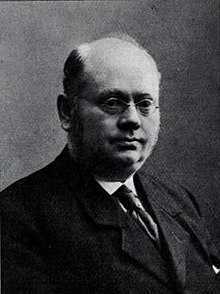Cæsar Peter Møller Boeck
Cæsar Peter Møller Boeck [ ˈbuːk ] (born September 28, 1845 in Lier , Drammen , † March 17, 1917 in Kristiania, now Oslo ) was a Norwegian dermatologist . Boeck became particularly famous for the description of sarcoid , also known as Boeck's disease.
resume
Cæsar Peter Møller Boeck was born in Lier , a suburb of the Norwegian city of Drammen . His father, Cæsar Boeck (1807-1884), was a ship's captain, his mother was Ellen Petronelle Holter (1819-1884). His family originally came from Flanders , where his grandfather immigrated to Norway in the 18th century to become successful in the timber business.
He grew up in Drammen and completed his school education here, which he completed in 1864. He then began his medical studies in Christiania (now Oslo) and completed it in 1871. He then worked sporadically at Rigshospitalet, the municipal hospital of Christiania, and in 1872 as epidemiologist in Sarpsborg , where in the year, a typhoid - epidemic broke out. He then worked as a general practitioner in the area of the city of Brevik .
From 1874 to 1875 Cæsar Boeck toured Austria , England and France . Boeck stayed in Vienna for seven months and worked with Ferdinand von Hebra (1816–1880) at his dermatological institute.
After returning to Norway, he first worked in Egersund as an epidemiologist for an outbreak of smallpox and went back to the Rikshospitalet in 1878 as an assistant doctor in the local skin clinic, where his uncle Carl Wilhelm Boeck (1808–1875) was chief physician. He represented this during a brief illness of the same. In addition to his work, he devoted some time to international congresses on dermatology and went to Germany and France from 1885 to 1886 to learn new methods of microscopy and study various skin diseases. He spent most of this time in Paris .
On September 14, 1882, Cæsar Boeck married Hansine Doxrud (1862–1953). On January 1, 1889, he became chief physician at the Rikshospitalet dermatological clinic . On January 30, 1895 he was appointed associate professor at the university's medical faculty, and then in 1896 full professor of medicine.
Boeck attended a number of international congresses during his career. In 1880 he was one of the four vice-presidents at a medical conference in Berlin . He was also present at the first four international dermatological conferences (Paris 1889, Vienna 1892, London 1896 and Paris 1900). In 1898 he gave the opening address at the annual meeting of the British Medical Association and in 1902 he was the official representative of the Norwegian government at the international conference in Brussels on the "Prevention of Syphilis and Other Venous Diseases ".
During his career he received various honorary professorships and was a member, honorary member and corresponding member of a number of medical associations. On February 4, 1911 he was made a Knight of the St. Olav Order (Ridder av Sankt Olavs Orden). In 1915 Cæsar Boeck retired from his professorship. He died on March 17, 1917 of angina pectoris .
In addition to medicine, Bock was primarily concerned with art , especially painting . He was a regular visitor to museums and also used his travels to look at the collections of other countries. In 1917, the year he died, he published the treatise Rembrandt og Saskia i deres hjem . He bequeathed his art collection to the city of Drammen.
Scientific achievements
During his entire medical career, Cæsar Peter Møller Boeck dealt with a wide variety of diseases, especially skin diseases. His work on sarcoid , also known as Boeck's disease, is particularly important to this day. He first described this disease comprehensively in 1899, although he had previously written a number of publications on the subject. In 1904 he described the disease again to a 36-year-old police officer who showed changes in the skin and lymph nodes .
Boeck made other significant contributions to the Hutchinson's pupil , Hutchinson's teeth , Mortimer's disease and meningitis described by Van Bogaert .
Boeck also researched syphilis. The patients were not treated by him, but were isolated during the highly contagious stages I and II. In an extensive study of around 2000 patients, he examined and described the natural course of the disease.
Together with Mikael Skjelderup (1834–1902) and Fredrik Stabell (1832–99) he founded the magazine Tidsskrift for Praktisk Medicin (1881–1886). In addition, he was responsible for a comprehensive work of specialist publications.
Web links
- Biography (with complete list of publications)
- Lars Walløe: Cæsar Boeck . In: Norsk biografisk leksikon
Individual evidence
- ^ E. Gurney Clark, Niels Danbolt: The Oslo study of the natural history of untreated syphilis: An epidemiologic investigation based on a restudy of the Boeck-Bruusgaard material a review and appraisal . In: Journal of Chronic Diseases . Volume 2, No. 3, 1955, pp. 311-344. doi : 10.1016 / 0021-9681 (55) 90139-9
| personal data | |
|---|---|
| SURNAME | Boeck, Cæsar Peter Møller |
| BRIEF DESCRIPTION | Norwegian dermatologist |
| DATE OF BIRTH | September 28, 1845 |
| PLACE OF BIRTH | Lier , Drammen |
| DATE OF DEATH | March 17, 1917 |
| Place of death | Kristiania |
